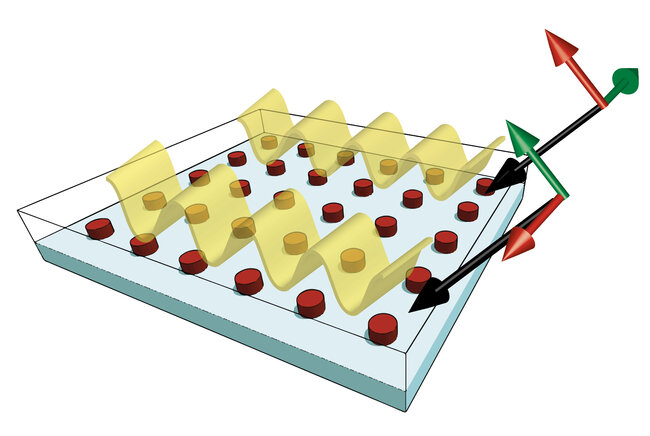Regular arrays of silicon nanoparticles key to improving light emissions in nanophotonic devices
Paper from TU/e researchers selected to mark International Day of Light 2020 within nanophotonics field.

Nanophotonics considers how light and matter at the nanoscale interact with each other, with findings in the field being important for nanofabrication techniques and in future photonic devices. Until recently, metallic nanoparticles have been predominantly used in nanophotonic devices. Nowadays though, semiconductor materials such as silicon are being considered for the nanoparticles. Researchers from Eindhoven University of Technology (TU/e) and the University of Kyoto have published two key papers in relation to nanophotonic configurations based on silicon. To mark the International Day of Light 2020, one paper, published in the journal ACS Photonics, has been selected as one of the top papers in the field of photonics over the past year.
The field of nanophotonics considers the interaction of nanoparticles with light when nanoparticle size is approximately the same as the wavelength of the light. Control of this so-called resonant response can have positive implications for developing new nanofabrication techniques and for practical applications such as improving the efficiency of solar cells and LEDs and photodetector sensitivities.
Focus shifted to silicon
Historically, the nanophotonics community employed metallic nanoparticles, where free charges in the particles oscillate after interaction with the electric field of the incoming electromagnetic wave (light). In recent years, the focus has shifted to nanoparticles made from semiconductor materials, such as silicon, where the light interacts with electrons bound to the atom, as opposed to free charges. As for metallic nanoparticles, interactions between light and semiconductor nanoparticles can manifest an oscillatory or resonant response.
Researchers at the Institute for Photonic Integration (IPI) and the Department of Applied Physics led by Prof. Jaime Gómez Rivas, in collaboration with the University of Kyoto, are actively investigating the use of semiconductor nanostructure for nanophotonics. Recently, they published two key findings in the journals Advanced Optical Materials and ACS Photonics.
Strong coupling between organic materials and silicon nanoparticles
A new avenue of research relates to the strong coupling regime, where interactions between light and the nanoparticle materials are strong enough to change the fundamental properties of the material. In fact, a hybridization results where matter assumes some light properties and the light takes on some of the matter properties. When organic materials are used in optoelectronic devices, a key issue is the degradation of the materials when illuminated and the short distance over which charges can propagate. Strong coupling would help to limit these negative effects.
In their first paper, which is published in ACS Photonics, Gabriel Castellanos and co-workers achieved a strong coupling for both electric and magnetic oscillations between organic materials and arrays of polycrystalline silicon nanoparticles. This finding paves the way for the use of silicon-based materials in optoelectronic organic devices, which could lead to augmented performance. To mark the International Day of Light (May 16th 2020), this article was selected by the journal ACS Photonics, which is published by the American Chemical Society, as one of the 24 most relevant papers in the field of photonics between May 2019 and May 2020.
Enhanced Light Emission
In the second paper, Shunsuke Murai and co-workers demonstrated that regular arrays of polycrystalline silicon nanoparticles (different shapes and sizes) that couple to each other can isolate electric and magnetic oscillations. As a result, when dye molecules are close to the arrays, stronger coupling between the dye molecules and the silicon nanoparticle arrays results in enhanced emission of light from the molecules. For instance, a 20-fold enhancement is observed in certain directions when coupled to the electric field of nanoparticles arrays, while a fivefold enhancement results when there is coupling with the magnetic field. This can have implications for the design of future LEDs.